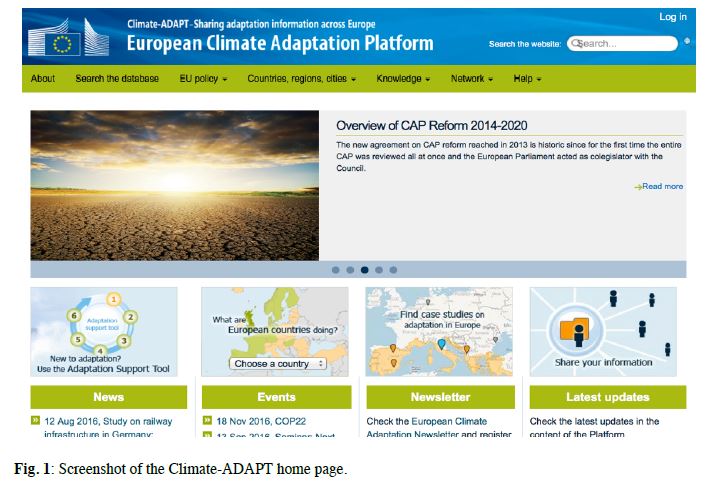D4.5 Link to Climate-ADAPT
In response to the call for better-informed decisions and evidence-based policy-making and action, current efforts are concentrated not only on the production of sufficient, relevant and credible climateclimate
Climate in a narrow sense is usually defined as the average weather, or more rigorously, as the statistical description in terms of the mean and variability of relevant quantities over a period of time ranging from months to thousands or millions of years. The classical period for averaging these variables is 30 years, as defined by the World Meteorological Organization. The relevant quantities are most often surface variables such as temperature, precipitation and wind. Climate in a wider sense is the state, including a statistical description, of the climate system. data, information and knowledge, but also on the adequate and effective dissemination of these products. In addition to the traditional dissemination channels such as the publication of reports and journal papers, and the participation in project meetings and conferences, which target mainly members of the academic and scientific circles, recently we have observed an increase in the number of web portals and knowledge platforms developed to reach a wider audience.

At a theoretical level the potential as well as the usefulness of such web-based dissemination channels is well acknowledged and valid. Yet, the continuous and rapid increase in their number and the fact that most of them have been and continue being developed ‘in isolation’, without taking into consideration other existing portals and platforms, or their products and services, cast doubts on their real added value and, indeed, the need for them. Additionally, as many of the newly established web portals have been developed in the context of projects with a limited lifespan, their maintenance and updating beyond the end of the project funding period are often uncertain, if not unlikely, putting the sustainability of the portals and platforms themselves, as well as of the developments they host in question.
Establishing links between the well-established portals and platforms and those developed more recently may help overcome the aforementioned challenges up to a certain extent and allow portals to complement each other. This report presents part of the results of the task 4.3 ‘Impact Indicator Toolkit’ of the CLIPC project. Work Package (WP) 4, ‘Visualisation and Integration’, looks at the integration and visualisation of the data and components produced and collected in the context of the CLIPC. Within this WP, task 4.3 investigates among others, the ways through which we can link the European Climate AdaptationAdaptation
The process of adjustment to actual or expected climate and its effects. In human systems, adaptation seeks to moderate harm or exploit beneficial opportunities. In natural systems, human intervention may facilitate adjustment to expected climate and its effects. Platform (Climate-ADAPT) and the Climate Information Portal for Copernicus (CLIPC portal), namely to identify if and how the CLIPC developments (i.e. concepts and prototypes) can be integrated and operationalised in the Climate-ADAPT platform. The report presents some realistic proposals for this purpose. These refer to the submission of new items to the Climate-ADAPT database (i.e. Research and knowledge projects; Indicators), and the introduction of knowledge tools (i.e. Mapviewer / Time series; Indicators tool) and the update of existing content (i.e. Observation and Scenarios; C3S page; UncertaintyUncertainty
Lack of precision or unpredictability of the exact value at a given moment in time. It does not usually imply lack of knowledge. Often, the future state of a process may not be predictable, such as a roll with dice, but the probability of finding it in a certain state may be well known (the probability of rolling a six is 1/6, and flipping tails with a coin is 1/2). In climate science, the dice may be loaded, and we may refer to uncertainties even with perfect knowledge of the odds. Uncertainties can be modelled statistically in terms of pdfs, extreme value theory and stochastic time series models. Guidance; Glossary) on the Climate-ADAPT website. Institutional and others links, some of which go beyond the boundaries of Climate-ADAPT, are also discussed.
Download the deliverable here